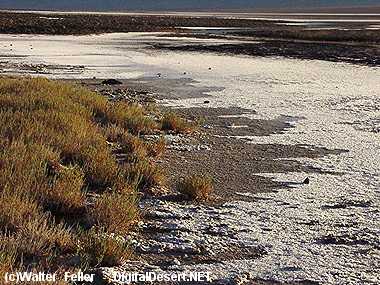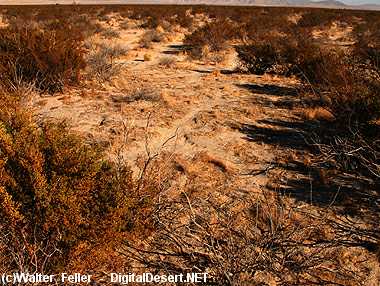Life in Extreme Conditions
The Mojave Desert is the driest and smallest desert in North America. It covers roughly 55,000 square miles of the continent's dry land, but with its flat salt areas, rough mountain tops, high sand hills, and salty springs, it has quite a variety of habitats for more than 2,500 types of plants and animals, including over 100 species at risk. <-- The Mojave Desert is the driest and smallest desert in North America. It covers only 7% of the continent's dry land, but with its flat salt areas, rough mountain tops, high sand hills, and salty springs, it has quite a variety of habitats for more than 2,500 types of plants and animals, including over 100 species at risk. -->Weather and Precipitation The Mojave gets less than 15 cm (6 inches) in a year, and it can even vary in a region. Portions of California's Mojave get as little as 3 cm (1.2 inches) of rainfall in a year. Because the mountains surrounding the desert block the rain, it is under a rain shadow. As a result, there have been extremes in places, such as Bagdad, California, which once went an amazing 767 days without rain.
Summers are lengthy and very hot. In 1913, Death Valley registered the hottest temperature in North America: 57C (134F).
Plant Life
Most vegetation in the Mojave Desert is low and scrubby; there are many shrubs, mostly creosote bush and Mojave sage. Trees do not generally grow in these deserts; however, its most recognizable plant is the Joshua tree. Those spiky, weird-looking trees feel so much a part of the desert landscape that their distribution pretty much defines the bounds of Mojave. Also, 25% of all species in this desert, such as cacti, wildflowers, and parasitic plants, are not found anywhere else on Earth.Some small areas still contain plants found only in the Mojave. Farther up, in mountain ranges like the Spring Mountains, forests of coniferous trees are quite distinct from the dry lower slopes dominated by shrubs.
Wildlife
The Mojave is home to both wide-ranging species and highly specialized ones. You’ll find adaptable animals like the desert bighorn sheep and jackrabbit alongside rare species limited to small relict habitats, such as the Inyo Mountain slender salamander and various pupfish, which thrive in isolated springs and streams.Riparian Zones: Corridors Full of Life
Water is a precious and scarce resource in the Mojave. Riparian zones on the Colorado, Mojave, and Amargosa rivers, as well as small springs and streams, become critical habitats for many plants and animals. Unfortunately, this land is under threat due to human activities such as water diversion and the introduction of invasive species, which disturb these sensitive ecosystems. Conclusion The Mojave Desert has very high and very low temperatures and many living things.Of course, this is not easy living, and plants and animals have adapted themselves with unique characteristics that help them to survive in this beautiful yet harsh environment.
< Previous - Overview - Next >
Also see:
Mojave Desert Ecology
An ecosystem is a biotic community together with its physical environment, considered as an integrated ...Water Sources
Where there is water, there is is life. In the desert, there is life.
Post Office Spring - Ballarat - Ghost Town

The King Clone creosote ring is estimated to be about 9,400 years old